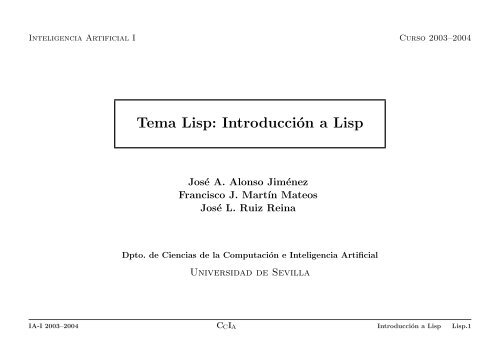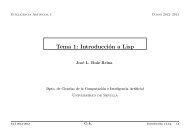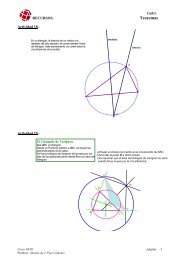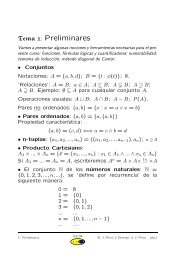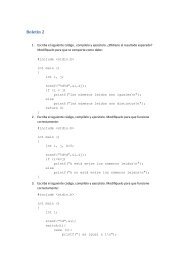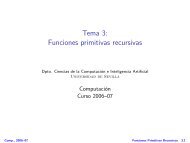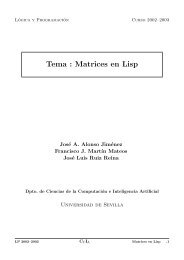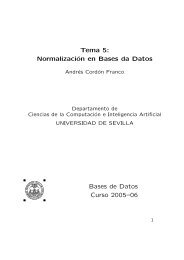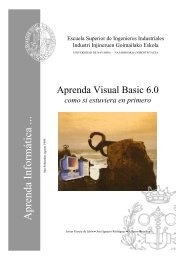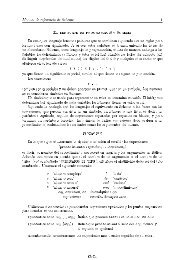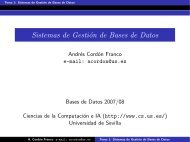Tema Lisp - Dpto. Ciencias de la Computación e Inteligencia Artificial.
Tema Lisp - Dpto. Ciencias de la Computación e Inteligencia Artificial.
Tema Lisp - Dpto. Ciencias de la Computación e Inteligencia Artificial.
You also want an ePaper? Increase the reach of your titles
YUMPU automatically turns print PDFs into web optimized ePapers that Google loves.
<strong>Inteligencia</strong> <strong>Artificial</strong> I Curso 2003–2004<br />
<strong>Tema</strong> <strong>Lisp</strong>: Introducción a <strong>Lisp</strong><br />
José A. Alonso Jiménez<br />
Francisco J. Martín Mateos<br />
José L. Ruiz Reina<br />
<strong>Dpto</strong>. <strong>de</strong> <strong>Ciencias</strong> <strong>de</strong> <strong>la</strong> Computación e <strong>Inteligencia</strong> <strong>Artificial</strong><br />
Universidad <strong>de</strong> Sevil<strong>la</strong><br />
IA-I 2003–2004 CcIa Introducción a <strong>Lisp</strong> <strong>Lisp</strong>.1
Introducción a <strong>Lisp</strong><br />
1<br />
John McCarthy, 1958<br />
1<br />
LISt Processing<br />
✉<br />
Lambda cálculo<br />
✉<br />
Procesamiento simbólico<br />
1<br />
Lenguaje interpretado<br />
✉<br />
Bucle lee, evalúa, escribe<br />
✉<br />
Compi<strong>la</strong>dor<br />
1<br />
Common <strong>Lisp</strong>: Clisp, GCL, CMUCL, Allegro. . .<br />
1<br />
1<br />
1<br />
<strong>Inteligencia</strong> <strong>Artificial</strong><br />
Prototipado Rápido<br />
Eficiencia<br />
IA-I 2003–2004 CcIa Introducción a <strong>Lisp</strong> <strong>Lisp</strong>.2
Introducción a <strong>Lisp</strong><br />
1<br />
Expresiones<br />
> 1<br />
1<br />
> (+ 2 3)<br />
5<br />
> (+ (- 5 2) (* 3 3))<br />
12<br />
1<br />
Primeras observaciones:<br />
✉<br />
Notación prefija: función y argumentos. Paréntesis. Expresiones anidadas<br />
✉<br />
Atomos y listas<br />
✉<br />
Sintácticamente simple<br />
1<br />
1<br />
1<br />
Bucle: lee, evalúa, imprime<br />
Compi<strong>la</strong>ción: compile-file<br />
Salida: (exit)<br />
IA-I 2003–2004 CcIa Introducción a <strong>Lisp</strong> <strong>Lisp</strong>.3
Introducción a <strong>Lisp</strong><br />
1<br />
Evaluación<br />
> (+ (- 5 2) (* 3 3))<br />
12<br />
1<br />
Reg<strong>la</strong> <strong>de</strong> evaluación (básica)<br />
✉<br />
Evaluación <strong>de</strong> los argumentos<br />
✉<br />
De izquierda a <strong>de</strong>recha<br />
✉<br />
Los valores se pasan a <strong>la</strong> función<br />
1<br />
1<br />
Todo se evalúa<br />
La función quote:<br />
> (quote (+ (- 5 2) (* 3 3)))<br />
(+ (- 5 2) (* 3 3))<br />
> ’(+ (- 5 2) (* 3 3))<br />
(+ (- 5 2) (* 3 3))<br />
IA-I 2003–2004 CcIa Introducción a <strong>Lisp</strong> <strong>Lisp</strong>.4
Introducción a <strong>Lisp</strong><br />
1<br />
Algunos tipos <strong>de</strong> datos<br />
✉<br />
Enteros: 1, 13, 245<br />
1<br />
✉<br />
Símbolos: a, x, juan<br />
✉<br />
Listas: (esto (es) (una lista))<br />
quote para evitar evaluaciones<br />
> x<br />
*** - EVAL: variable X has no value<br />
1. Break> abort<br />
> ’x<br />
X<br />
> (esto (es) (una lista))<br />
*** - EVAL: un<strong>de</strong>fined function ESTO<br />
1. Break> abort<br />
> ’(esto (es) (una lista))<br />
(ESTO (ES) (UNA LISTA))<br />
IA-I 2003–2004 CcIa Introducción a <strong>Lisp</strong> <strong>Lisp</strong>.5
1<br />
1<br />
Introducción a <strong>Lisp</strong><br />
La lista vacía<br />
> ()<br />
NIL<br />
> nil<br />
NIL<br />
> ’()<br />
NIL<br />
> ’nil<br />
NIL<br />
Operaciones con listas<br />
> (list ’a (+ 1 2) nil)<br />
(A 3 NIL)<br />
> (cons ’a ’(b c d))<br />
(A B C D)<br />
> (cons ’a (cons ’b nil))<br />
(A B)<br />
> (list ’a ’b)<br />
(A B)<br />
> (car ’(a b c))<br />
A<br />
> (cdr ’(a b c))<br />
(B C)<br />
IA-I 2003–2004 CcIa Introducción a <strong>Lisp</strong> <strong>Lisp</strong>.6
Introducción a <strong>Lisp</strong><br />
1<br />
Predicados y valores <strong>de</strong> verdad<br />
✉<br />
Predicados:<br />
> (listp ’(a b c))<br />
T<br />
> (listp 27)<br />
NIL<br />
✉<br />
El doble papel <strong>de</strong> nil. Verdad como distinto <strong>de</strong> nil<br />
> (null nil)<br />
T<br />
> (not nil)<br />
T<br />
IA-I 2003–2004 CcIa Introducción a <strong>Lisp</strong> <strong>Lisp</strong>.7
Introducción a <strong>Lisp</strong><br />
1<br />
La forma especial if<br />
1<br />
> (if (listp ’(a b c)) (+ 1 2) (+ 5 6))<br />
3<br />
> (if (listp 4) (+ 1 2) (+ 5 6))<br />
11<br />
Las macros and y or<br />
> (and (listp ’(1)) 3 (+ 13 4))<br />
17<br />
> (or (listp ’(1)) 3 (+ 13 4))<br />
T<br />
> (and (listp ’(1)) (listp 1) t)<br />
NIL<br />
> (or (listp 1) (= 2 3))<br />
NIL<br />
IA-I 2003–2004 CcIa Introducción a <strong>Lisp</strong> <strong>Lisp</strong>.8
Introducción a <strong>Lisp</strong><br />
1<br />
1<br />
1<br />
Funciones<br />
> (<strong>de</strong>fun cuadrado (x)<br />
(* x x))<br />
CUADRADO<br />
> (cuadrado 4)<br />
16<br />
Los programas son funciones (paradigma funcional)<br />
Recursión<br />
> (<strong>de</strong>fun pertenece (x l)<br />
(if (endp l) ; caso base<br />
nil<br />
(if (= x (car l)) ; caso base<br />
l<br />
(pertenece x (cdr l))))) ; recursion<br />
PERTENECE<br />
> (pertenece 3 ’(1 4 3 5 6))<br />
(3 5 6)<br />
> (pertenece 8 ’(1 4 3 5 6))<br />
NIL<br />
IA-I 2003–2004 CcIa Introducción a <strong>Lisp</strong> <strong>Lisp</strong>.9
Introducción a <strong>Lisp</strong><br />
1<br />
1<br />
1<br />
1<br />
Entrada-Salida frente a evaluación<br />
Salida: función format<br />
> (format t "~a mas ~a igual a ~a. ~%" 2 3 (+ 2 3))<br />
2 mas 3 igual a 5.<br />
NIL<br />
Entrada: función read<br />
> (<strong>de</strong>fun pi<strong>de</strong> (frase)<br />
(format t "~a " frase)<br />
(read))<br />
PIDE<br />
> (pi<strong>de</strong> "Su edad, por favor:")<br />
Su edad, por favor: 23<br />
23<br />
Algunas observaciones<br />
✉<br />
Lectura <strong>de</strong> expresiones <strong>Lisp</strong><br />
✉<br />
Secuencialidad en programas<br />
✉<br />
Efectos co<strong>la</strong>terales<br />
IA-I 2003–2004 CcIa Introducción a <strong>Lisp</strong> <strong>Lisp</strong>.10
Introducción a <strong>Lisp</strong><br />
1<br />
Variables locales y globales<br />
> (let ((x 1) (y 2))<br />
(+ x y))<br />
3<br />
> x<br />
*** - EVAL: variable X has no value<br />
> (<strong>de</strong>fparameter *glob* 3)<br />
*GLOB*<br />
> *glob*<br />
3<br />
IA-I 2003–2004 CcIa Introducción a <strong>Lisp</strong> <strong>Lisp</strong>.11
Introducción a <strong>Lisp</strong><br />
1<br />
Asignaciones con setf<br />
> (setf *glob* 98)<br />
98<br />
> (let ((n 10))<br />
(setf n 2)<br />
n)<br />
2<br />
> (setf x ’(a b c))<br />
(A B C)<br />
> x<br />
(A B C)<br />
> (setf (car x) ’n)<br />
N<br />
> x<br />
(N B C)<br />
> (setf a ’b c ’d e ’f)<br />
F<br />
> (list a c e)<br />
(B D F)<br />
IA-I 2003–2004 CcIa Introducción a <strong>Lisp</strong> <strong>Lisp</strong>.12
Introducción a <strong>Lisp</strong><br />
1<br />
El paradigma <strong>de</strong> <strong>la</strong> programación funcional<br />
✉<br />
Valores vs. Modificaciones<br />
> (setf x ’(a b c d))<br />
(A B C D)<br />
> (remove ’b x)<br />
(A C D)<br />
> x<br />
(A B C D)<br />
> (setf x (remove ’b x))<br />
(A C D)<br />
> x<br />
(A C D)<br />
1<br />
La programación sin efectos co<strong>la</strong>terales es preferible aunque no obligatoria<br />
IA-I 2003–2004 CcIa Introducción a <strong>Lisp</strong> <strong>Lisp</strong>.13
Introducción a <strong>Lisp</strong><br />
1<br />
Funciones como objetos<br />
> (function +)<br />
#<br />
> (symbol-function ’+)<br />
#<br />
> #’+<br />
#<br />
> (apply #’+ ’(1 2 3))<br />
6<br />
> (funcall #’+ 1 2 3)<br />
6<br />
> (<strong>la</strong>mbda (x) (+ x 100))<br />
#<br />
> ((<strong>la</strong>mbda (x) (+ x 100)) 4)<br />
104<br />
> (funcall #’(<strong>la</strong>mbda (x) (+ x 100)) 4)<br />
104<br />
IA-I 2003–2004 CcIa Introducción a <strong>Lisp</strong> <strong>Lisp</strong>.14
Funciones <strong>de</strong> construcción <strong>de</strong> listas<br />
1<br />
Funciones básicas <strong>de</strong> creación<br />
* (CONS X Y)<br />
(cons ’a ’b) => (A . B)<br />
(cons ’a ’(b c)) => (A B C)<br />
(cons ’a (cons ’b (cons ’c ’()))) => (A B C)<br />
(cons ’(a b) ’(c d)) => ((A B) C D)<br />
* (LIST X-1 ... X-N)<br />
(list ’a ’b ’c) => (A B C)<br />
(list ’(a b) ’(c d)) => ((A B) (C D))<br />
(list) => NIL<br />
(list (list ’a ’b)<br />
(list ’c ’d ’e)) => ((A B) (C D))<br />
* (APPEND L-1 ... L-N)<br />
(append ’(a) ’(b) ’(c) ’(x y)) => (A B C X Y)<br />
(append ’(a b) ’(c d)) => (A B C D)<br />
* (REVERSE L)<br />
(reverse ’(a (b c) d)) => (D (B C) A)<br />
1<br />
Listas y pares punteados<br />
IA-I 2003–2004 CcIa Introducción a <strong>Lisp</strong> <strong>Lisp</strong>.15
Funciones <strong>de</strong> acceso a listas<br />
* (FIRST L), (CAR L)<br />
(first ’(a b c)) => A<br />
(first ()) => NIL<br />
* (REST L), (CDR L)<br />
(rest ’(a b c)) => (B C)<br />
(rest ()) => NIL<br />
* (SECOND L)<br />
(second ’(a b c d)) => B<br />
(second ’(a)) => NIL<br />
* (NTH N L)<br />
(nth 2 ’(a b c d)) => C<br />
* (LENGTH L)<br />
(length ’(a (b c) d)) => 3<br />
* (SUBSEQ L I J)<br />
(subseq ’(a b c d e f g h) 2 5) => (C D E)<br />
IA-I 2003–2004 CcIa Introducción a <strong>Lisp</strong> <strong>Lisp</strong>.16
Funciones aritméticas<br />
* (+ X-1 ... X-N)<br />
(+ 3 7 5) => 15<br />
* (- X-1 ... X-N)<br />
(- 123 7 5) => 111<br />
(- 3) => -3<br />
* (* X-1 ... X-N)<br />
(* 2 7 5) => 70<br />
* (/ X Y)<br />
(/ 6 2) => 3<br />
(/ 5 2.0) => 2.5<br />
* (MOD X Y)<br />
(mod 7 2) => 1<br />
* (EXPT X Y)<br />
(expt 2 3) => 8<br />
* (SQRT X)<br />
(sqrt 16) => 4<br />
IA-I 2003–2004 CcIa Introducción a <strong>Lisp</strong> <strong>Lisp</strong>.17
Valores lógicos y predicados aritméticos<br />
1<br />
Valores lógicos: NIL, (), T.<br />
1<br />
Predicados aritméticos:<br />
* (= X-1 ... X-N)<br />
(= 2 2.0 (+ 1 1)) => T<br />
(= 1 2 1) => NIL<br />
* (> X-1 ... X-N)<br />
(> 4 3 2 1) => T<br />
(> 4 3 3 2) => NIL<br />
* (>= X-1 ... X-N)<br />
(>= 4 3 3 2) => T<br />
(>= 4 3 3 5) => NIL<br />
* (< X-1 ... X-N)<br />
* (
Predicados <strong>de</strong> tipos<br />
* (ATOM X)<br />
(atom 3) => T<br />
(atom ’ho<strong>la</strong>) => T<br />
(atom ’(1 2 3)) => NIL<br />
* (SYMBOLP X)<br />
(symbolp ’a) => T<br />
(symbolp 3) => NIL<br />
* (NUMBERP X)<br />
(numberp 4) => T<br />
(numberp 3.4) => T<br />
(numberp ’(1)) => NIL<br />
* (CONSP X)<br />
(consp ’(1 . 2))<br />
(consp nil)<br />
(consp ’(2 5))<br />
=> T<br />
=> NIL<br />
=> T<br />
* (NULL X)<br />
(null (rest ’(a b))) => NIL<br />
(null (rest ’(a))) => T<br />
IA-I 2003–2004 CcIa Introducción a <strong>Lisp</strong> <strong>Lisp</strong>.19
Predicados <strong>de</strong> igualdad<br />
* (EQ X Y)<br />
(eq 3 3) => T<br />
(eq 3 3.0) => NIL<br />
(eq 3.0 3.0) => NIL<br />
(eq (first ’(a b c)) ’a) => T<br />
(eq (cons ’a ’(b c)) ’(a b c)) => NIL<br />
* (EQL X Y)<br />
(eql 3.0 3.0) => T<br />
(eql (cons ’a ’(b)) (cons ’a ’(b))) => NIL<br />
* (EQUAL X Y)<br />
(equal (cons ’a ’(b)) (cons ’a ’(b))) => T<br />
IA-I 2003–2004 CcIa Introducción a <strong>Lisp</strong> <strong>Lisp</strong>.20
Operadores lógicos<br />
* (NOT X)<br />
(not (= (+ 1 1) 2)) => NIL<br />
(not (= (+ 1 1) 3)) => T<br />
* (OR E-1 ... E-N)<br />
(or nil 2 3) => 2<br />
(or (eq ’a ’b) (eq ’a ’c)) => NIL<br />
* (AND E-1 ... E-N)<br />
(and 1 nil 3) => NIL<br />
(and 1 2 3) => 3<br />
IA-I 2003–2004 CcIa Introducción a <strong>Lisp</strong> <strong>Lisp</strong>.21
Condicionales<br />
* (IF TEST ENTONCES [EN-CASO-CONTRARIO])<br />
(if (> 2 1) 1 2) => 1<br />
(if (> 1 2) 1) => NIL<br />
* (WHEN TEST E-1 ... E-N)<br />
(when (= 1 1) 1 2 3) => 3<br />
(when (= 1 2) 1 2 3) => NIL<br />
* (UNLESS TEST E-1 ... E-N)<br />
(unless (= 1 1) 1 2 3) => NIL<br />
(unless (= 1 2) 1 2 3) => 3<br />
* (COND L-1 ... L-N)<br />
> (<strong>de</strong>fun notas (n)<br />
(cond ((< n 5) ’suspenso)<br />
((< n 7) ’aprobado)<br />
((< n 9) ’notable)<br />
(t ’sobresaliente) ))<br />
NOTAS<br />
> (notas 8)<br />
NOTABLE<br />
IA-I 2003–2004 CcIa Introducción a <strong>Lisp</strong> <strong>Lisp</strong>.22
Predicado <strong>de</strong> pertenencia y listas <strong>de</strong> asociación<br />
1<br />
1<br />
Pertenencia:<br />
* (MEMBER E L [:TEST #’PREDICADO])<br />
(member ’x ’(a x b x c)) => (X B X C)<br />
(member ’x ’(a (x) b))<br />
=> NIL<br />
(setf l ’((a b) (c d))) => ((A B) (C D))<br />
(member ’(c d) l)<br />
=> NIL<br />
(member 2.0 ’(1 2 3))<br />
=> NIL<br />
(member ’(c d) l :test #’equal) => ((C D))<br />
(member 2.0 ’(1 2 3) :test #’=) => (2 3)<br />
(member 2.0 ’(1 2 3) :test #’ (3)<br />
Listas <strong>de</strong> asociación:<br />
* (ASSOC ITEM A-LISTA [:TEST PREDICADO])<br />
(assoc ’b ’((a 1) (b 2) (c 3))) => (B 2)<br />
(assoc ’(b) ’((a 1) ((b) 1) (c d))) => NIL<br />
(assoc ’(b) ’((a 1) ((b) 1) (c d)) :test #’equal) => ((B) 1)<br />
IA-I 2003–2004 CcIa Introducción a <strong>Lisp</strong> <strong>Lisp</strong>.23
Definiciones recursivas<br />
1<br />
Definición <strong>de</strong> factorial<br />
> (<strong>de</strong>fun factorial (n)<br />
(if (= n 0)<br />
1<br />
(* n (factorial (- n 1)))))<br />
FACTORIAL<br />
> (factorial 3)<br />
6<br />
IA-I 2003–2004 CcIa Introducción a <strong>Lisp</strong> <strong>Lisp</strong>.24
Definiciones recursivas<br />
* (TRACE F-1 ... F-N)<br />
> (trace factorial *)<br />
(FACTORIAL *)<br />
> (factorial 2)<br />
1. Trace: (FACTORIAL ’2)<br />
2. Trace: (FACTORIAL ’1)<br />
3. Trace: (FACTORIAL ’0)<br />
3. Trace: FACTORIAL ==> 1<br />
3. Trace: (* ’1 ’1)<br />
3. Trace: * ==> 1<br />
2. Trace: FACTORIAL ==> 1<br />
2. Trace: (* ’2 ’1)<br />
2. Trace: * ==> 2<br />
1. Trace: FACTORIAL ==> 2<br />
2<br />
> (untrace)<br />
(* FACTORIAL)<br />
* (UNTRACE F-1 ... F-N)<br />
IA-I 2003–2004 CcIa Introducción a <strong>Lisp</strong> <strong>Lisp</strong>.25
Recursión en <strong>Lisp</strong><br />
1<br />
Ejemplo: función subconjunto<br />
;;; (SUBCONJUNTO L1 L2)<br />
;;; > (subconjunto () ’(s 3 e 4))<br />
;;; T<br />
;;; > (subconjunto ’(4 3) ’(s 3 e 4))<br />
;;; T<br />
;;; > (subconjunto ’(4 a 3) ’(s 3 e 4))<br />
;;; NIL<br />
(<strong>de</strong>fun subconjunto (l1 l2)<br />
(if (endp l1)<br />
t<br />
(and (member (first l1) l2)<br />
(subconjunto (rest l1) l2))))<br />
IA-I 2003–2004 CcIa Introducción a <strong>Lisp</strong> <strong>Lisp</strong>.26
Recursión en <strong>Lisp</strong><br />
1<br />
Ejemplo: función elimina-uno<br />
;;; (ELIMINA-UNO X L)<br />
;;; > (elimina-uno 3 ’(a b c d))<br />
;;; (A B C D)<br />
;;; > (elimina-uno ’b ’(a b c d))<br />
;;; (A C D)<br />
;;; > (elimina-uno ’b ’(a b c b d))<br />
;;; (A C B D)<br />
(<strong>de</strong>fun elimina-uno (x l)<br />
(cond ((endp l) l)<br />
((equal x (first l)) (rest l))<br />
(t (cons (first l) (elimina-uno x (rest l))))))<br />
IA-I 2003–2004 CcIa Introducción a <strong>Lisp</strong> <strong>Lisp</strong>.27
Recursión en <strong>Lisp</strong><br />
1<br />
Ejemplo: función permutacion<br />
;;; (PERMUTACION L1 L2)<br />
;;; > (permutacion ’(x 1 3 4) ’(3 2 x 4))<br />
;;; NIL<br />
;;; > (permutacion ’(x 2 3 4) ’(3 2 x 4))<br />
;;; T<br />
;;; > (permutacion ’(x 2 3 4) ’(3 2 x 4 4))<br />
;;; NIL<br />
(<strong>de</strong>fun permutacion (l1 l2)<br />
(cond ((endp l1) (endp l2))<br />
((member (car l1) l2)<br />
(permutacion (rest l1)<br />
(elimina-uno (car l1) l2)))<br />
(t nil)))<br />
IA-I 2003–2004 CcIa Introducción a <strong>Lisp</strong> <strong>Lisp</strong>.28
Recursión en <strong>Lisp</strong><br />
1<br />
Recursión cruzada: funciones par-p e impar-p<br />
;;; (PAR-P N), (IMPAR-P N)<br />
;;; > (par-p 4)<br />
;;; T<br />
;;; > (impar-p 10)<br />
;;; NIL<br />
(<strong>de</strong>fun par-p (n)<br />
(cond ((= n 0) t)<br />
((= n 1) nil)<br />
(t (impar-p (- n 1)))))<br />
(<strong>de</strong>fun impar-p (n)<br />
(cond ((= n 0) nil)<br />
((= n 1) t)<br />
(t (par-p (- n 1)))))<br />
IA-I 2003–2004 CcIa Introducción a <strong>Lisp</strong> <strong>Lisp</strong>.29
Recursión en <strong>Lisp</strong><br />
1<br />
Ejemplo: función comprime<br />
;;; (COMPRIME LISTA)<br />
;;; > (comprime ’(a a b c c c a d d d d d e))<br />
;;; ((2 A) B (3 C) A (5 D) E)<br />
;;; > (comprime ’(a b c c a d e))<br />
;;; (A B (2 C) A D E)<br />
(<strong>de</strong>fun comprime (l)<br />
(if (consp l) (comprime-aux (first l) 1 (rest l)) l))<br />
(<strong>de</strong>fun comprime-aux (x n l)<br />
(if (endp l)<br />
(list (n-elementos x n))<br />
(let ((siguiente (car l)))<br />
(if (eql x siguiente)<br />
(comprime-aux x (+ n 1) (rest l))<br />
(cons (n-elementos x n)(comprime-aux siguiente 1 (rest l)))))))<br />
(<strong>de</strong>fun n-elementos (x n) (if (> n 1) (list n x) x))<br />
IA-I 2003–2004 CcIa Introducción a <strong>Lisp</strong> <strong>Lisp</strong>.30
Bucles con LOOP<br />
1<br />
Ejemplos <strong>de</strong> uso <strong>de</strong> LOOP:<br />
> (let ((res nil))<br />
(loop for x from 1 to 7 do<br />
(setf res (cons x res)))<br />
res)<br />
(7 6 5 4 3 2 1)<br />
> (loop for x from 1 to 7 collect (* x x))<br />
(1 4 9 16 25 36 49)<br />
> (loop for x from 1 to 7<br />
when (evenp x)<br />
collect (* x x))<br />
(4 16 36)<br />
> (loop for x from 1 to 7<br />
when (evenp x)<br />
summing (* x x))<br />
56<br />
> (loop for x from 1 to 7 by 2 collect (* x x))<br />
(1 9 25 49)<br />
> (loop for x in ’(1 3 5) summing x)<br />
9<br />
IA-I 2003–2004 CcIa Introducción a <strong>Lisp</strong> <strong>Lisp</strong>.31
Bucles con LOOP<br />
1<br />
Ejemplos:<br />
> (let ((x 3)<br />
(res nil))<br />
(loop while (> x 0) do<br />
(setf res (cons x res)<br />
x (- x 1)))<br />
res)<br />
(1 2 3)<br />
> (let ((x 3)<br />
(res nil))<br />
(loop until ( (loop for l in<br />
’((a b c) (d e f) (g h i))<br />
append l)<br />
(A B C D E F G H I)<br />
IA-I 2003–2004 CcIa Introducción a <strong>Lisp</strong> <strong>Lisp</strong>.32
Bucles con LOOP<br />
1<br />
Ejemplos:<br />
> (<strong>de</strong>fun factor (x)<br />
(or (loop for i from 2 to (sqrt x)<br />
thereis (when (= (mod x i) 0)<br />
i))<br />
x))<br />
FACTOR<br />
> (factor 35)<br />
5<br />
> (<strong>de</strong>fun es-primo (x)<br />
(= x (factor x)))<br />
ES-PRIMO<br />
> (es-primo 7)<br />
T<br />
> (es-primo 35)<br />
NIL<br />
> (loop for x from 2 to 100<br />
count (es-primo x))<br />
25<br />
IA-I 2003–2004 CcIa Introducción a <strong>Lisp</strong> <strong>Lisp</strong>.33
Bucles con LOOP<br />
> (<strong>de</strong>fun primos-gemelos (x)<br />
(when (and (es-primo x)<br />
(es-primo (+ x 2)))<br />
(list x (+ x 2))))<br />
PRIMOS-GEMELOS<br />
> (loop for i from 200 to 2000<br />
thereis (primos-gemelos i))<br />
(227 229)<br />
> (loop for x from 2 to 100<br />
count (primos-gemelos x))<br />
8<br />
> (<strong>de</strong>fun suma-primeros-impares (x)<br />
(let ((res 0))<br />
(loop until (null x) do<br />
(if (= (mod (first x) 2) 0)<br />
(return res)<br />
(setf res (+ res (first x))<br />
x (rest x))))<br />
res))<br />
SUMA-PRIMEROS-IMPARES<br />
> (suma-primeros-impares ’(1 3 2 5 6))<br />
4<br />
IA-I 2003–2004 CcIa Introducción a <strong>Lisp</strong> <strong>Lisp</strong>.34
Bucles con LOOP<br />
1<br />
1<br />
Opciones iniciales:<br />
(LOOP FOR FROM TO ...)<br />
(LOOP FOR FROM TO <br />
BY ...)<br />
(LOOP FOR IN ...)<br />
(LOOP WHILE ...)<br />
(LOOP UNTIL ...)<br />
Opciones centrales:<br />
(LOOP ... WHEN ...)<br />
1<br />
Opciones finales:<br />
(LOOP ... DO )<br />
(LOOP ... COLLECT )<br />
(LOOP ... APPEND )<br />
(LOOP ... THEREIS )<br />
(LOOP ... COUNT )<br />
(LOOP ... SUMMING )<br />
IA-I 2003–2004 CcIa Introducción a <strong>Lisp</strong> <strong>Lisp</strong>.35
Matrices<br />
1<br />
Creación:<br />
(MAKE-ARRAY DIMENSIONES<br />
[:INITIAL-CONTENTS EXPRESION])<br />
> (make-array ’(2 2))<br />
#2A((NIL NIL) (NIL NIL))<br />
> (make-array ’(2 2 1))<br />
#3A(((NIL) (NIL)) ((NIL) (NIL)))<br />
> (make-array ’(2 2) :initial-element 2)<br />
#2A((2 2) (2 2))<br />
> (make-array ’(3 3)<br />
:initial-contents ’((a b c)<br />
(1 2 3)<br />
(x y z)))<br />
#2A((A B C) (1 2 3) (X Y Z))<br />
> (setf *matriz*<br />
(make-array ’(3 3)<br />
:initial-contents ’((a b c)<br />
(1 2 3)<br />
(x y z))))<br />
#2A((A B C) (1 2 3) (X Y Z))<br />
IA-I 2003–2004 CcIa Introducción a <strong>Lisp</strong> <strong>Lisp</strong>.36
Matrices<br />
1<br />
1<br />
Acceso:<br />
(AREF MATRIZ INDICE-1 ... INDICE-N)<br />
> *matriz*<br />
#2A((A B C) (1 2 3) (X Y Z))<br />
> (aref *matriz* 0 0)<br />
A<br />
> (aref *matriz* 1 1)<br />
2<br />
> (aref *matriz* 2 2)<br />
Z<br />
Modificación:<br />
(SETF (AREF MATRIZ INDICE-1 ... INDICE-N) EXPRESION)<br />
> *matriz-2*<br />
#2A((1 2 3) (8 H 4) (7 6 5))<br />
> (setf (aref *matriz-2* 1 2) ’h)<br />
H<br />
> (setf (aref *matriz-2* 1 1) 4)<br />
4<br />
> *matriz-2*<br />
#2A((A B C) (1 4 H) (X Y Z))<br />
IA-I 2003–2004 CcIa Introducción a <strong>Lisp</strong> <strong>Lisp</strong>.37
Matrices<br />
1<br />
Ejemplo<br />
;;; (SUMA-COLUMNAS MATRIZ)<br />
;;; > (setf mat<br />
;;; (make-array ’(3 3)<br />
;;; :initial-contents<br />
;;; ’((1 2 3) (4 5 6) (7 8 9))))<br />
;;; #2A((1 2 3) (4 5 6) (7 8 9))<br />
;;; > (suma-columnas mat)<br />
;;; #(12 15 18)<br />
(<strong>de</strong>fun suma-columnas (a)<br />
(let* ((dim (array-dimensions a))<br />
(f (first dim))<br />
(c (second dim))<br />
(res (make-array (list c))))<br />
(loop for i from 0 to (- c 1)<br />
do (setf (aref res i)<br />
(loop for j from 0 to (- f 1)<br />
summing (aref a j i))))<br />
res))<br />
IA-I 2003–2004 CcIa Introducción a <strong>Lisp</strong> <strong>Lisp</strong>.38
Escritura<br />
1<br />
La función format:<br />
(FORMAT DESTINO CADENA-DE-CONTROL X-1 ... X-N)<br />
> (format t "~&Linea 1 ~%Linea 2")<br />
Linea 1<br />
Linea 2<br />
NIL<br />
> (format t "~&El cuadrado <strong>de</strong> ~a es ~a" 3 (* 3 3))<br />
El cuadrado <strong>de</strong> 3 es 9<br />
NIL<br />
> (setf l ’(a b c))<br />
(A B C)<br />
> (format t<br />
"~&La longitud <strong>de</strong> <strong>la</strong> lista ~a es ~a"<br />
l (length l))<br />
La longitud <strong>de</strong> <strong>la</strong> lista (A B C) es 3<br />
NIL<br />
IA-I 2003–2004 CcIa Introducción a <strong>Lisp</strong> <strong>Lisp</strong>.39
Escritura<br />
1<br />
Algunas directivas <strong>de</strong> <strong>la</strong> función format:<br />
~a escribe el siguiente argumento<br />
~&<br />
comienza nueva línea,<br />
si no está al comienzo <strong>de</strong> una<br />
~% comienza nueva línea<br />
~Na<br />
escribe el siguiente argumento<br />
más los espacios suficientes para<br />
ocupar N caracteres <strong>de</strong> ancho<br />
IA-I 2003–2004 CcIa Introducción a <strong>Lisp</strong> <strong>Lisp</strong>.40
Lectura<br />
1<br />
La función read<br />
(READ)<br />
> (read)<br />
a<br />
A<br />
> (setf a (read))<br />
2<br />
2<br />
> a<br />
2<br />
> (* (+ (read) (read))<br />
3<br />
4<br />
7<br />
> (read)<br />
(+ 2 3)<br />
(+ 2 3)<br />
IA-I 2003–2004 CcIa Introducción a <strong>Lisp</strong> <strong>Lisp</strong>.41
Lectura<br />
1<br />
read no evalúa. Función eval:<br />
(EVAL EXPRESION)<br />
> (eval (read))<br />
(+ 2 2)<br />
4<br />
1<br />
Ejemplo:<br />
(<strong>de</strong>fun calcu<strong>la</strong>-cuadrados ()<br />
(loop<br />
(let ((aux (read)))<br />
(if (numberp aux)<br />
(format t "~&El cuadrado <strong>de</strong> ~a es ~a~%"<br />
aux (* aux aux))<br />
(return ’fin)))))<br />
IA-I 2003–2004 CcIa Introducción a <strong>Lisp</strong> <strong>Lisp</strong>.42
Estructuras (ejemplo)<br />
> (<strong>de</strong>fstruct persona<br />
(nombre nil)<br />
(estado ’casado)<br />
(calle nil)<br />
(ciudad ’Sevil<strong>la</strong>))<br />
PERSONA<br />
> (setf ejemplo-1<br />
(make-persona :nombre ’ana :calle ’(Reina Merce<strong>de</strong>s)))<br />
#S(PERSONA :NOMBRE ANA :ESTADO CASADO :CALLE (REINA MERCEDES) :CIUDAD SEVILLA)<br />
> (setf ejemplo-2<br />
(make-persona :nombre ’pepe :ciudad ’Huelva))<br />
#S(PERSONA :NOMBRE PEPE :ESTADO CASADO :CALLE NIL :CIUDAD HUELVA)<br />
> (persona-ciudad ejemplo-1)<br />
SEVILLA<br />
> (persona-nombre ejemplo-2)<br />
PEPE<br />
> (setf (persona-nombre ejemplo-1) ’(Ana Maria))<br />
(ANA MARIA)<br />
> ejemplo-1<br />
#S(PERSONA :NOMBRE (ANA MARIA) :ESTADO CASADO<br />
:CALLE (REINA MERCEDES) :CIUDAD SEVILLA)<br />
IA-I 2003–2004 CcIa Introducción a <strong>Lisp</strong> <strong>Lisp</strong>.43
Estructuras (ejemplo)<br />
> (setf ejemplo-3 ejemplo-1)<br />
#S(PERSONA :NOMBRE (ANA MARIA) :ESTADO CASADO<br />
:CALLE (REINA MERCEDES) :CIUDAD SEVILLA)<br />
> (setf (persona-calle ejemplo-3) ’(tetuan))<br />
(TETUAN)<br />
> ejemplo-3<br />
#S(PERSONA :NOMBRE (ANA MARIA) :ESTADO CASADO<br />
:CALLE (TETUAN) :CIUDAD SEVILLA)<br />
> ejemplo-1<br />
#S(PERSONA :NOMBRE (ANA MARIA) :ESTADO CASADO<br />
:CALLE (TETUAN) :CIUDAD SEVILLA)<br />
> (setf ejemplo-4 (copy-persona ejemplo-2))<br />
#S(PERSONA :NOMBRE PEPE :ESTADO CASADO :CALLE NIL :CIUDAD HUELVA)<br />
> (setf (persona-ciudad ejemplo-4) ’cadiz)<br />
CADIZ<br />
> ejemplo-4<br />
#S(PERSONA :NOMBRE PEPE :ESTADO CASADO :CALLE NIL :CIUDAD CADIZ)<br />
> ejemplo-2<br />
#S(PERSONA :NOMBRE PEPE :ESTADO CASADO :CALLE NIL :CIUDAD HUELVA)<br />
IA-I 2003–2004 CcIa Introducción a <strong>Lisp</strong> <strong>Lisp</strong>.44
Estructuras<br />
1<br />
1<br />
1<br />
Creación <strong>de</strong> estructuras con <strong>de</strong>fstruct:<br />
(DEFSTRUCT (NOMBRE (:CONSTRUCTOR FUNCION-CONSTRUCTURA)<br />
(:CONC-NAME PREFIJO-)<br />
(:PRINT-FUNCTION FUNCION-DE-ESCRITURA))<br />
CAMPO-1<br />
...<br />
CAMPO-N)<br />
Ejemplo (puntos en el p<strong>la</strong>no):<br />
(<strong>de</strong>fstruct (punto (:constructor crea-punto)<br />
(:conc-name coor<strong>de</strong>nada-)<br />
(:print-function escribe-punto)<br />
x<br />
y)<br />
Ejemplo (función <strong>de</strong> escritura):<br />
(<strong>de</strong>fun escribe-punto (punto &optional (canal t) profundidad)<br />
(format canal "Punto <strong>de</strong> abcisa ~a y or<strong>de</strong>nada ~a"<br />
(coor<strong>de</strong>nada-x punto)<br />
(coor<strong>de</strong>nada-y punto)))<br />
IA-I 2003–2004 CcIa Introducción a <strong>Lisp</strong> <strong>Lisp</strong>.45
Estructuras (ejemplo)<br />
> (setf *punto-1* (crea-punto :x 2 :y 3))<br />
Punto <strong>de</strong> abcisa 2 y or<strong>de</strong>nada 3<br />
> (coor<strong>de</strong>nada-y *punto-1*)<br />
3<br />
> (setf (coor<strong>de</strong>nada-y *punto-1*) 5)<br />
5<br />
> *punto-1*<br />
Punto <strong>de</strong> abcisa 2 y or<strong>de</strong>nada 5<br />
> (punto-p *punto-1*)<br />
T<br />
> (punto-p ’(2 5))<br />
NIL<br />
IA-I 2003–2004 CcIa Introducción a <strong>Lisp</strong> <strong>Lisp</strong>.46
Estructuras (ejemplo)<br />
> (setf *punto-2* (copy-punto *punto-1*))<br />
Punto <strong>de</strong> abcisa 2 y or<strong>de</strong>nada 5<br />
> (equal *punto-1* *punto-2*)<br />
NIL<br />
> (equalp *punto-1* *punto-2*)<br />
T<br />
> (setf (coor<strong>de</strong>nada-y *punto-2*) 3)<br />
3<br />
> *punto-2*<br />
Punto <strong>de</strong> abcisa 2 y or<strong>de</strong>nada 3<br />
> (setf *punto-3* (crea-punto :y 3 :x 2))<br />
Punto <strong>de</strong> abcisa 2 y or<strong>de</strong>nada 3<br />
> (equalp *punto-2* *punto-3*)<br />
T<br />
IA-I 2003–2004 CcIa Introducción a <strong>Lisp</strong> <strong>Lisp</strong>.47
Variables locales<br />
* (LET ((VAR-1 VAL-1)...(VAR-M VAL-M)) E-1 ... E-N)<br />
(setf a 9 b 7) => 7<br />
(let ((a 2)(b 3)) (+ a b)) => 5<br />
(+ a b) => 16<br />
(let ((x 2)(y (+ 1 x))) (+ x y)) => Error<br />
* (LET* ((VAR-1 VAL-1) ... (VAR-N VAL-N)) E-1 ... E-M)<br />
(let* ((x 2)(y (+ 1 x))) (+ x y)) => 5<br />
IA-I 2003–2004 CcIa Introducción a <strong>Lisp</strong> <strong>Lisp</strong>.48
Argumentos c<strong>la</strong>ve y opcionales<br />
1<br />
Argumentos opcionales<br />
(<strong>de</strong>fun factorial (n &optional (resultado 1))<br />
(if (= n 0)<br />
resultado<br />
(factorial (- n 1) (* n resultado))))<br />
(factorial 3) => 6<br />
(factorial 3 4) => 24<br />
1<br />
Argumentos c<strong>la</strong>ve<br />
(<strong>de</strong>fun f (&key (x 1) (y 2))<br />
(list x y))<br />
(f :x 5 :y 3) => (5 3)<br />
(f :y 3 :x 5) => (5 3)<br />
(f :y 3) => (1 3)<br />
(f) => (1 2)<br />
IA-I 2003–2004 CcIa Introducción a <strong>Lisp</strong> <strong>Lisp</strong>.49
Valores <strong>de</strong> un símbolo<br />
1<br />
Hemos visto:<br />
DATOS EN LISP:<br />
- Números: 3, 2.5, 14.3, ...<br />
- Ca<strong>de</strong>nas: "ho<strong>la</strong>", "el perro come", ...<br />
- Símbolos: adios, fun, fact, cuadrado, ...<br />
- Listas: (1 s 3), (1 (a (b))), ...<br />
- Estructuras<br />
- Matrices, etc.<br />
1<br />
Un nuevo tipo <strong>de</strong> dato: funciones.<br />
✉<br />
Expresadas mediante <strong>la</strong>mbda<br />
(<strong>la</strong>mbda (x) (* x x))<br />
(<strong>la</strong>mbda (x y) (cond ((> x 0) 1)<br />
((< x 0) -1)<br />
(t 0)))<br />
IA-I 2003–2004 CcIa Introducción a <strong>Lisp</strong> <strong>Lisp</strong>.50
Valores <strong>de</strong> un símbolo<br />
1<br />
Estos datos funcionales se pue<strong>de</strong>n asignar a símbolos:<br />
> (setf (symbol-value ’cuadrado) 8)<br />
8<br />
> (setf (symbol-function ’cuadrado)<br />
(<strong>la</strong>mbda (x) (* x x)))<br />
#<br />
1<br />
Usualmente:<br />
> (setf cuadrado 8)<br />
8<br />
> (<strong>de</strong>fun cuadrado (x) (* x x))<br />
CUADRADO<br />
IA-I 2003–2004 CcIa Introducción a <strong>Lisp</strong> <strong>Lisp</strong>.51
Evaluación en <strong>Lisp</strong><br />
✉<br />
Constantes que no sean listas: el valor representado<br />
Ejemplos: 1, 3, "ho<strong>la</strong>"<br />
✉<br />
Lambdas: <strong>la</strong> función representada<br />
Ejemplo: (<strong>la</strong>mbda (x) (* 2 x))<br />
✉<br />
Símbolos (sin quote): su valor como variable<br />
Ejemplo: cuadrado => 8<br />
IA-I 2003–2004 CcIa Introducción a <strong>Lisp</strong> <strong>Lisp</strong>.52
Evaluación en <strong>Lisp</strong> (continuación)<br />
✉<br />
Listas (E1 E2 ... En)<br />
* Se evalúa el VALOR FUNCIONAL <strong>de</strong> E1.<br />
- Si es un símbolo: valor funcional.<br />
- Una <strong>la</strong>mbda-expresión: <strong>la</strong> función que representa.<br />
* Se evalúan E2 ... En (los argumentos) recursivamente.<br />
* Se "aplica" <strong>la</strong> función obtenida en primer lugar a los<br />
valores <strong>de</strong> los argumentos.<br />
Ejemplo: (cuadrado 4) => 16<br />
(cuadrado cuadrado) => 64<br />
((<strong>la</strong>mbda (m n) (+ m n))<br />
(cuadrado 2) cuadrado) => 12<br />
✉<br />
Quote (’Exp): el valor representado por Exp<br />
Ejemplo: ’(cuadrado 4) => (cuadrado 4)<br />
✉<br />
La función function (#’Exp): valor funcional <strong>de</strong> Exp<br />
Ejemplos: #’cuadrado => #<br />
#’(<strong>la</strong>mbda (x) (* 2 x)) =><br />
#<br />
IA-I 2003–2004 CcIa Introducción a <strong>Lisp</strong> <strong>Lisp</strong>.53
Funciones como argumentos <strong>de</strong> entrada: FUNCALL y APPLY<br />
1<br />
La función FUNCALL<br />
(FUNCALL FN E-1 ... E-N)<br />
(funcall #’+ 1 2 3) => 6<br />
(funcall #’cuadrado 4) => 16<br />
(funcall #’(<strong>la</strong>mbda (x) (* 2 x)) 3) => 6<br />
1<br />
La función APPLY<br />
(APPLY FN ARGS)<br />
(apply #’+ ’(1 2 3)) => 6<br />
(apply #’max ’(4 5 7)) => 7<br />
(apply #’(<strong>la</strong>mbda (x y) (* 2 x y)) ’(3 4)) => 24<br />
1<br />
Observaciones:<br />
✉<br />
El primer argumento <strong>de</strong> funcall y <strong>de</strong> apply <strong>de</strong>be ser algo cuyo valor sea una función<br />
✉<br />
Uso <strong>de</strong> #’ para forzar a obtener el valor funcional<br />
✉<br />
A veces es necesario symbol-function<br />
IA-I 2003–2004 CcIa Introducción a <strong>Lisp</strong> <strong>Lisp</strong>.54
Funciones como argumentos <strong>de</strong> entrada (otras)<br />
* (MAPCAR FN L)<br />
(mapcar #’(<strong>la</strong>mbda (x) (* x x)) ’(1 2 3 4 5)) => (1 4 9 16 25)<br />
(mapcar #’atom ’(a (b) 3)) => (T NIL T)<br />
* (REMOVE-IF-NOT PREDICADO L), (REMOVE-IF PREDICADO L)<br />
(remove-if-not #’atom ’((a) b (c) d)) => (B C)<br />
(remove-if #’atom ’((a) b (c) d))<br />
=> ((A) (C))<br />
* (COUNT-IF PREDICADO L), (COUNT-IF-NOT PREDICADO L)<br />
(count-if #’atom ’((a) b (c) d e)) => 3<br />
(count-if-not #’atom ’((a) b (c) d e)) => 2<br />
* (FIND-IF PREDICADO L), (FIND-IF-NOT PREDICADO L)<br />
(find-if #’atom ’((a) b (c) d e))<br />
(find-if-not #’atom ’((a) b (c) d e))<br />
=> B<br />
=> (A)<br />
IA-I 2003–2004 CcIa Introducción a <strong>Lisp</strong> <strong>Lisp</strong>.55
Funciones como argumentos <strong>de</strong> entrada (otras)<br />
* (POSITION-IF PREDICADO L), (POSITION-IF-NOT PREDICADO L)<br />
(position-if #’atom ’((x) b d (a) (c))) => 1<br />
(position-if-not #’atom ’(b d (a) (c))) => 2<br />
* (FIND-IF PREDICADO LISTA), (FIND-IF-NOT PREDICADO LISTA)<br />
(find-if #’atom ’((a) b (c) d e))<br />
(find-if-not #’atom ’((a) b (c) d e))<br />
=> B<br />
=> (A)<br />
IA-I 2003–2004 CcIa Introducción a <strong>Lisp</strong> <strong>Lisp</strong>.56
Funciones como argumentos <strong>de</strong> entrada (otras)<br />
* (EVERY PREDICADO L), (EVERY PREDICADO L1 ... LN)<br />
(every #’atom ’(1 a))<br />
(every #’atom ’((1) a))<br />
(every #’ T<br />
=> NIL<br />
=> T<br />
=> NIL<br />
* (SOME PREDICADO L), (SOME PREDICADO L1 ... LN)<br />
(some #’atom ’((1) a))<br />
(some #’atom ’((1) (a)))<br />
(some #’< ’(1 2) ’(1 3))<br />
(some #’< ’(1 2) ’(1 0))<br />
=> T<br />
=> NIL<br />
=> T<br />
=> NIL<br />
IA-I 2003–2004 CcIa Introducción a <strong>Lisp</strong> <strong>Lisp</strong>.57
Bibliografía<br />
1<br />
Graham, P. ANSI Common <strong>Lisp</strong> (Prentice Hall, 1995).<br />
1<br />
Steele, G.L. Common <strong>Lisp</strong> the Language, 2nd edition (D. P., 1990).<br />
http://www-2.cs.cmu.edu/afs/cs.cmu.edu/project/ai-repository/-<br />
ai/html/cltl/cltl2.html<br />
1<br />
Winston, P.R. y Horn, B.K. LISP (3a. ed.) (Addison–Wesley, 1991).<br />
IA-I 2003–2004 CcIa Introducción a <strong>Lisp</strong> <strong>Lisp</strong>.58


